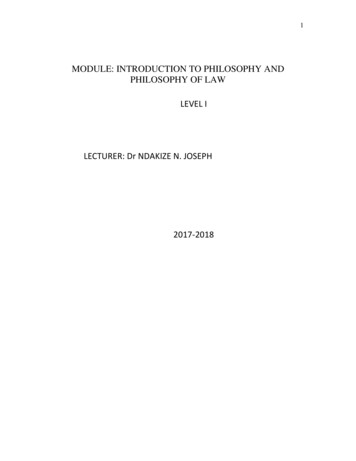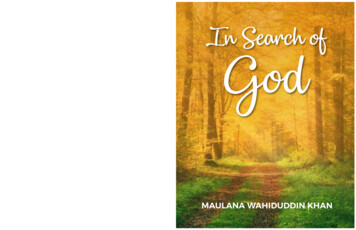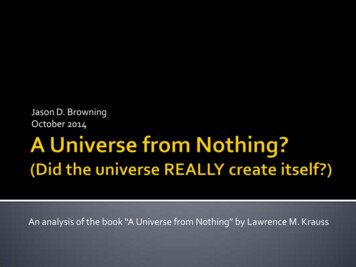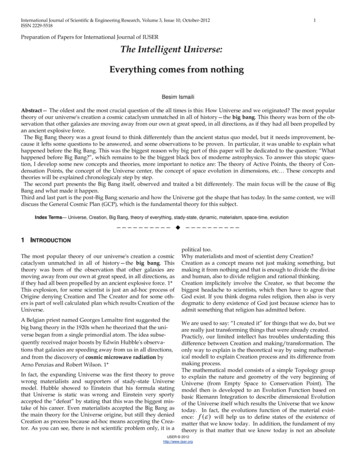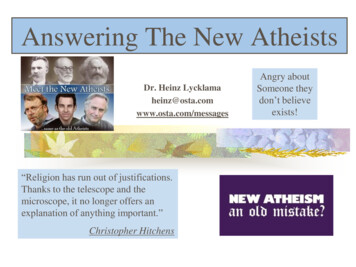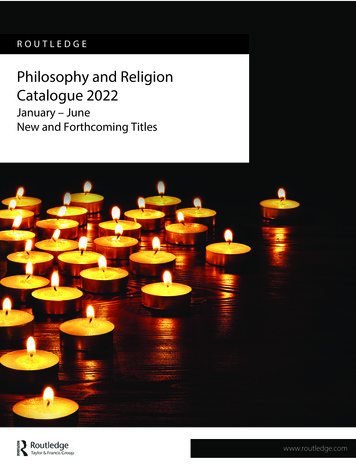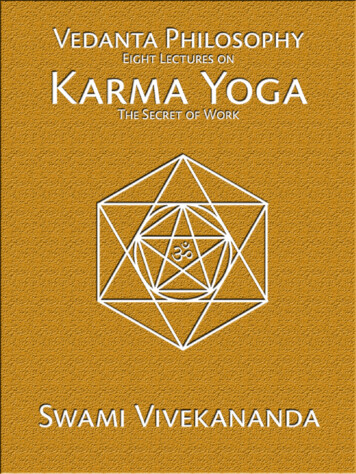
Transcription
Indian Philosophy and The UniverseUnited Nations/Costa Rica WorkshoponHuman Space TechnologySan Jose, Costa Rica7-11 March, 2016Anjana Vyas, Ph DProfessor & Programme Coordinator (Geomatics)Faculty of Technology, CEPT University, Ahmedabad,INDIAanjanavyas@yahoo.comLecture delivered on March 10, 2016
Indian Philosophy Philosophy is a fundamental nature of» knowledge,» Reality and» Existence Originated in the Indian sub-continent, includes:– Hindu Philosophy– Buddhist Philosophy– Jain Philosophy It is unique in its applications of analytical rigor tometaphysical/ supernatural/ philosophical problems It goes into very precise detail about:– the nature of reality,– structure and function of Human consciousness, and– how the relationship between the two have important implications forhuman salvation, i.e., MOKSH
Indian Philosophy Significance lies in the eternal principles ofhuman frailty, strength, beauty and destiny. Organic growth, which is like a tree constantlyproducing more branches from the sameroots, has turned Hinduism into a religion anda philosophy in which there is room foreveryone to have their own place.
Questions Addressed in Indian Philosophy Who am I? Where have I come from? Why have I come? What is the essential nature of my being (Gyaan – selfrealisation)? What is my relationship with the manifold universe and withother human beings? What is truth and conclusions on questions of truth? What is the relationship between the centre of consciousnessand the objects of the world? (Bhakti - prayer) What are the guidelines for action (Karma - deed) as long asone is in a physical body? Does one live after death (Moksha – Eternal Journey)?
Indian Philosophy – Across HUMAN Each person has its own character or talents. For a person with a:PersonalityDesired PathPhilosophical BentKNOWLEDGE (Gyan)Practical BentDEEDS (Karma)Disciplined PersonReligious PersonSPIRITUAL CONTROL (Yoga)WORSHIP (Bhakti) Life is divided into 4 stages called ASHRAM:StagesActivity DefinedBrahmcharyaDiscipline & EducationGrahsthyaParenthood & Active WorkVanyaprasthyaStage of retreat in which worldly ties areloosened, Middle AgeSanyasa AshramLife of Hermit, Old Age
Evolution of Caste Every person has an individual place & Tasks to fulfil inSociety:CastesTasks Responsible hudraLabourers
Fundamental Difference in Western & Indian PhilosophyWestern PhilosophyIndian PhilosophyIntellectual PursuitEssence of TruthDisciplinary ApproachHolistic ApproachCompetitiveComprehensivePractical OrientationTheory oriented PracticalReligion is independent to culture Religion derived cultureLinear (Birth & Death)Cyclic (Birth, Re-birth)
The Universe - Brahmand Aham brahmasmi: An expression of I am ness; I am in all and allare in me, it is a state of supreme eternal Brahma, the state ofoneness Tat tvamasi: expression of the relationship between the individualand the Absolute. "He that is the Essence of your soul, He is theTruth, He is the Self, thou art That”. Praghanam Brahman: Prajnana means awareness, consciousness,which is pervading the subtlest texture of the cosmos and ispresent and active everywhere, at all the places and all the time.It energizes the physical, emotional and spiritual realms. Sarvam Khalu Idam Brahman: All this multiplicity in the form ofuniverse or creation is essentially Brahman (Supreme Self or PureI AM Consciousness).Universe, therefore, is a formation in Brahman orPure I AM Consciousness.
The UniverseSarvam Khalu Idam Bramh(Pure Knowledge is not a means to an end but the end itself)The Universe is Everything: Both living & inanimate Both Atoms & Galaxies Spiritual Things & Material (if exists)Heaven & Hell (If exist)
The Universe: Totality of All Things Totality of All Things - which can be experienced through:– Sense - Organs (PERCEPTION)– Reason (CONCEPTION)– More directly by transcendental KNOWLEDGE Non-Material entities: Space Time Ether Consciousness – Realisation Universe is Expanding-Law of Hubble – i.e., 1) Balloon hasdots, expands, distance increases, BUT the center of Universeremains; 2) There exists Parallel Universe
The Universe:Theoretical QueryCharacteristics of a ‘Thing’ is not Absolutely ONE, or AbsolutelyMANY:a) just because it possesses an unbroken contour or identityof its material;i. i.e., a lump of garden soil is one or many?b) One’s point of view – common sensei. One always changesThe only thing which could be absolutely ‘ONE’ is the whole‘REALITY’ itself.
The Universe: Fundamental Doctrines1. Idealism: ‘All Reality is Mental’; Nothing exists but state ofConsciousness.(Philosophers- Plato, Leibnitz, Berkeley, Hume, Kant, Hegel & Scientists- Sir,Eddington, Sir James Jeans, Hermann Weyl, Ernst Mach, RaymondPoincare, etc. who supports)2. Realism: ‘Independence of any relation to the experience ofa subject’, What exists, exists equally whether it isexperienced or not.– In consideration with Substance - Element Quality - Value Change - Variation(Philosophers Democritus, Aristotle, Rene Descartes, Bertrand Russell &scientists Newton, Bohr, Albert Einstein, Hisenberg, Whittaker,Reichenbach, Joad, Sir Oliver Lodge, Prof. Henry Margenau support)
Hinduism It is more than a Religion It is a way of Life that has developed over approximately5 Millennia It is rich & multi-cultured history It has made the structure of MYTHICAL and PHILOSOPHICALprinciples into a highly differentiated maze Practically impossible to get the Total knowledge of this. (Ref. Eva Rudy Janse, The Book on Hindu Imagery) Ghnanm Vighyana SahitamEinstein quotes: Science without Religion is Deaf & Religionwithout Science is Blind.Eye is a Vision: Microscope, Telescopes equates Spirituality & Religion
The Evolution of HinduismJudaism1750Buddhism Christianity Islam8005002007001200Vedic Period Pre-Epic EpicMedievalPeriod Period Common Era RenaissanceVedasBhagavad Gita Vedanta PhilosophyUpanishads1700ModernPeriod
Outline of Indian Philosophy Vedic Period (2500 B.C. – 600 B.C.)Epic Period (600 B.C. – 200 A.D.)Sutra Period (200 A.D. – 600 A.D.)Scholarly Period (600 A.D. – 1700 A.D.)The Modern Period (1700 – present) Composed in Sanskrit beginning as early as1,750 – 1,500 BCE
The Vedas
What are the Vedas? 4 Scriptures: brought knowledgeand wisdom to us. Those are: Rig, Yajur, Sama, andAtharva Veda. It holds the key to Spiritual wisdomand many more subjects withinthem. For example: ArtLiteratureSpace notismMedicineand more.
The Vedic Heritage - PhilosophyVedas are the most ancient scriptures, communicated from 4000 1500 B.C.VedaPhilosophyRig Veda Atma, Parmatma, Creation, Genesis, Death, Rebirth, Liberation A collection of poetic hymns invoking and glorifying many godsand goddesses which are personifications of different aspects ofnature. Agni, Vayu, Varuna, etc. Highly symbolic language withmetaphysical/ philosophical ramifications.Yajur Veda Sacrifices, Mantra, Bhakti Mantras used for sacrificial yagnas or extended ritualsSam Veda Hymns from Rig Veda, Karma Kand, Rituals Has mantras from Rig Veda but these follow certain rules ofprosody and tone for accuracy of effect. Relates to sound and itseffects on the human mind and body.Atharva Veda Prayers, Magic Chants, Philosophy, Meditation The mantras here deal with the ordinary world and acquisitionof material gains.
Vedic Knowledge as an Inverted TreeBramhan - GodNon - Dual Reality4 VedasVedic literature
Visualisation of Vedic Impacts5 Natural Elements:Water, Fire, Air, Earth& AtmosphereResources are forEveryone, leave forFuture Generation –IshavasyamidamSarvam Bhrugu Sanhita:10,000yrs before Minuteness in 2Celestial Age: 12 Rashi 27 Nakshtra 4 Charan 1/2 Charan i.e.,12*27*4*1/2is the Probability ofHuman taking birth
Brahman - “to expand” Fundamental Principle of the universe. (Kena UpanishadIV and V) Reality in all, and all things are in Brahman. (SvetasvataraUpanishad, IV. 2–4) State of non-duality. (Brhadaranyaka Upanishad, IV.v.14–15) Ineffable/ inaccessible. (Kena Upanishad, I.5-9)
The Vedic Heritage/ Literature Vedic literature is divided into four chronological stages –– Samhita consists of all the Vedic mantras.– Brahmana is the commentary on the meanings of the mantras.– Aranyaka gives methods for the training of the mind for higherattainment for aspirants to a spiritual life.– Upanisads – 108 prominent Upanisads, 11 of which are consideredprominent. Veda means “knowledge” and Vedanta means “the end ofknowledge”. This set of Vedic literature – a gigantic compilation of texts generatedby unknown sages – is the fertile ground from which have sprouted allthe different systems of Indian philosophy. There are orthodox and heterodox systems of Indian philosophy.– Orthodox ones are: Nyaya, Vaisesika, Samkhya, Yoga, Mimamsa andVedanta.– Heterodox (unorthodox) systems are Jain, Carvaka and Buddhism.
Scripts: 18 Puranas It talks about: ‘Always a birth of Every Thing’ – Scope forDevelopment – (Radio wave, x-ray, microwave are talked) 4 are important – Vishnu, Garud, Vayu, Brahmand Puran i.e., Jambudwip – Island with specific species of plants, herbs,etc Devi Bhagwat: explains the varied Geological Features ofPlanets (Jupiter, Saturn, Venus) Sun Temple, Jantar Mantar gives micro calculation of TIMEbased on the movement of Planets Panchangs are prepared based on Astronomy (Distance ofPlanets)
Anti-Matter Anti-matter is exactly the oppositeof normal matter. An anti-matter atom would consistof a positron, an anti-proton, andan anti-neutron. In theory this means that there is aparallel universe. This parallel universe could be thespiritual world.
Two Theories in Astronomy: Big Bang & Steady State Theorythe universe originatedthe universe has always existedbillions of years ago in anand has always been expandingexplosion from a singlewith hydrogen being createdpoint of nearly infinitecontinuously – Steady Stateenergy density – Big BangTheory (Now it is Over)TheoryOn 6th October,1923Cosmic Age(1/10*43) parts we havegone backBhrugu Rushi – 10,000 myrs before mentionedabout time: Ansh, Kala,13.7 Million Years – Creation of UniverseVikala: Degree, Min &In Sanskrut Big Bang mentioned in Ratri Sukta; Purush Sukta,a mention ofSecond.B I GB A N GHow Universe Begun, Nasidip Sukta – What happened before Big BangSuper-sensory Knowledge – not a science but is a consciousness.i.e. a spoonful of Tears – is a water. But of Happiness or Sorrow?
Three Forms of GODBrahmaVishnuShivaThe Trimurti (three forms) represent Brahman manifested in theprocesses of:creation, preservation, and dissolution of the cosmos.(In Purana – Composed during Gupta Period – 320-540 CE)
UpanishadUpa- (near), ni- (down), sad (to sit): sitting near the teacher
The Upanishads teachthat all life forms movethrough repeated cyclesof birth, death, andrebirth, until finalliberation from thiscycle, MOKSHA.Stage ofSarvam Khalu IdamBrahman
The Upanishads Composed between 800-500 BCE by various rishis (seers) The Upanishads are the greatest source of Indianphilosophical thought. Added as the final sections of the divisions of Vedas.(Vedanta end of the vedas) Upanishads are classified as sruti (“that which is heard”)and are authoritative. Upnishads are Philosophical commentary on the earlyportions of the Vedas, and it is grounded in the practicalexperiences of the rishis.
Six Primary Concepts in the UpanishadsAtmanBrahmanAvidyaKarmaSamsaraMoksha
Primary Concepts of HinduismWorld is a single Family. Vasudhaiv Kutumbakam.Sarvam Khalu Idam Brahman – OM – NothingnessNothingness has a particular Frequency, Dark Matter, DarkEnergy. Every thing has a GATI (dynamic) BRAHMAN: SUPREME REALITY OF GOD, i.e.,1. All pervading and absolute reality2. Beyond description3. Worshiped in various forms, male or female, and by manynames DHARMA:1. Mode of conduct most conducive to spiritualadvancement2. Includes universal human values and values specific to anindividual’s stage in life (i.e., student, parent)
Primary Concepts of Hinduism KARMA:1. Principle of cause and effect2. An individual’s every action produces an appropriateoutcome for him/her3. Outcomes may span over life time. MOKSHA: THE ULTIMATE GOAL IS 1. Freedom from samsara, the cycle of reincarnation (thesoul survives death to be reborn in a new body)2. Achieved by self-realization and elimination of materialdesires and attachments.
MeditationChanting mantras such as OM,signifies the cosmic power ofBrahmanAham Brahmasmi(I am Brahman).Moksha:freedom from the cycle ofreincarnation
The Epic Periodc The Ramayana of ValmikiRushi, written in 3rdcentury BC, and tells storyof Rama, and his wife, Sita. Rama and Sita aregenerally seen as idealexamples of great manlyheroism and wifelydevotion.
Mahabharata Mahabharata, Sanskrit forGreat Story, written by VyasMuni between 300BC &300AD, is one of the greatepic poems of ancientIndia. The story is about thebattle of one family over akingdom in northern India. The Bhagavad Gita (Song ofGod) is contained in theMahabharata. It is dialoguebetween Krishna and thehero Arjuna on themeaning of life.
Sutra Period Six systems of PhilosophyNyayaVaisesikaSamkhyaYogaPurva MimasaUttara Mimamsa or VedantaVedas: the unexplored ocean ofknowledge.
Buddhism
Early Buddhism in IndiaFounded by Siddhartha Gautama (born about 563B.C.) Siddharth/ Gautama was raised in a pamperedlifestyle but then he encountered an old man, a sickman, a corpse, and a monk– Siddharth was impressed by the monk and himselfdetermined to take up an ascetic, wandering life tohelp him understand the phenomenon of suffering
Siddhartha Gautama About 534 B. C., Gautama lefthis family to take up theexistence of a holy man Intense meditation andextreme asceticism did notenlighten him sufficiently One day he resolved to situnder a large bo tree until heunderstood the problem ofsuffering For 49 days he withstoodvarious temptations andthreats from demons andfinally received enlightenment– Thus Gautama became theBuddha– “the enlightenedone”The Buddha by Odilon Redon
Buddha – Teaching of a ManSterling point in Buddhism: Mankind and the way in which they suffer notjust physical pain but the general feelings ofdissatisfaction with LIFE craving to achieve orhave more the fear of CHANGE & DEATH.Buddhism does not require:a)A person to accept fixed belief and ideasb)No debate on the existence of “GOD”Main thing to help people overcome SUFFERING& to achieve a FULL LIFE.
2 Branches of ReligionHinayana & Mahayana Triple Jewel is COMMON among BOTH called TriRatna:BuddhaDharmaSanghaTri RatnaEnlightened OneTeachingCommunity of Monks
Buddhist Doctrine Buddha announced hisdoctrine publicly at theDeer Park of Sarnath in528 B.C. Delivered the “Turningof the Wheel of Law”sermon which markedthe beginning ofBuddha’s quest tospread the law ofrighteousnessDhamekha Stupa is believed tomark the place of Buddha’s firstsermon
Hinayana:4 Noble Truths & 8 Nobel PathsConducts & EthicsFour Noble Truths All life involvessuffering Desire is the cause ofsuffering Elimination of desirebrings an end tosuffering A disciplined life inaccordance with theNoble Eightfold Pathbrings the eliminationof desire Right ThoughtRight IntentRight SpeechRight ActionRight LivelihoodRight EffortRight MindfullnessRight ConcentrationConception of NIRVANA & Freedom from theCycle of Re-Birth
MAHAYANA Concept of Bodhisatwa: Being who desiredheighest enlightenment for the welfare ofothers. Meditative Practices SIX PARIMITA: Ordained Monks1. Dana MonasteryMeditation &2. ShilaIntrospection were3. Kshantiencouraged4. Birya5. Dhyana6. Praghna
The Middle Path or Moderate Way Avoid extremes– either an overt pursuit ofpassionate worldly desire or extremeasceticism Live a moderate lifestyle characterized byquiet contemplation, thoughtful reflection,and disciplined self-control– Reduces desire for material goods and otherworldly attractions– Eventually results in detachment from the worlditself
Nirvana Living this lifestyle will leadto personal salvation–escape from the cycle ofincarnation and theattainment of nirvana– Nirvana is the stateof perfect spiritualindependenceThe Wheel of Dharma symbolizessamsara, the continuous cycle of birth, life,and death. One is liberated from thisendless cycle of rebirth when nirvana isachieved.
Monasteries Early Indian education wasinformal, mostly involvingjust a sage and his students Buddhists organizedmonasteries and beganoffering regular instructionand established educationalinstitutions Most famous monasterywas at NalandaRuins of monastery atNalanda
Dunhuang Between 600 and 1000 A.D.,Buddhists built hundreds ofcave temples aroundDunhuang depicting scenesof Buddha Assembled libraries ofreligious literature Supported missionarieswhich spread Buddhismthroughout ChinaBoddhisattva Avalokitesvara,south wall, Cave 45
The Buddhist Monastery at Ajanta(2nd BCE-6th CE, west central India)
Gupta period paintings preserved in the oldest caves:
The Stupa/Image Hall (late 6th CE)
Inside the Hall:stupa & Buddhaimage mergedinto one
Ceiling & Side Columns:rock-cut imitation of wooden structure
Another Stupa/Image Hall
Ways in which Buddhism and Hinduismare similar: 1) Both believe in reincarnation. 2) Both believe there are many different paths toenlightenment. 3) Both believe that our suffering is caused by excessiveattachment to things and people in the physical world. 4) Both believe in an ultimate spiritual reality beyond theillusions of the physical world. 5) Both practice meditation and other forms of yoga. 6) Both believe that eventually all living spirits will achieveenlightenment and liberation, even if it takes manyincarnations. Remember that in Mahayana Buddhism, theoriginal teachings of the Buddha are assimilated to Hindupractices, including prayers, gods (even the Buddha as god inall his many incarnations). Mahayana Buddhism alsointroduces the idea of (temporary) heavens and hells.
Comparison ChartBuddhismHinduismPrincipleThis life is suffering, and the only way to escape fromthis suffering is to dispel one's cravings and ignoranceby practising the Eightfold Path.To follow dharma, i.e. eternal lawsPracticesPractices of the Threefold Training: Morality,Concentration, and Wisdom.Meditation, Yoga, contemplation, yagna(communal worship), offerings in thetemple.Goal ofPhilosophyBuddhism is not a philosophy. It is the practicalteachings of the Buddha and its goal is 'nirvana'.Salvation, freedom from the cycle of birthand reincarnation.Means ofsalvationBuddhism has nothing to do with "salvation". The onlygoal in Buddhism is to attain Nirvana. To do this, weshould let go of our desires, cravings and attachments,and try to dispel our ignoranceReaching enlightenment by the Path ofKnowledge, the Path of devotion, or thePath of Good Deeds.ScripturesTripitaka - a vast volume of 3 main sections: theDiscourses, the Discipline and the Absolute Doctrine which appeared only after the death of the Buddha,thanks to the monks who collected all the teachings ofthe Buddha.Vedas, Upanishad, Puranas, Gita. Smrti andSruti are oral scriptures.Belief of GodBuddhists do not believe in a Creator God, but, dohave non-creator deities.The deity often varies from sect to sect.Smarta/Monists sect believes Everything isGod. There are monotheistic sects also.
MEDICAL SCIENCEfrom VEDA Yoga and Ayurveda : Charak Sanhita
Vedic Math The Vedas were very advanced in math. The Vedas had short cuts to Multiplication andDivision. Many saints and sages were very advanced inall of these subjects including zero and infinity.
Vedic Math21*136211363210273Total:273Note: if the number of dots in onecolumn is more than 9 add to nextcolumn. This does not apply forthe first column
NikhilamMultiplication99 891) Write thebase5) Finally, crosssubtract(100)990189881111The answer is2) Find the firstcomplement3) And the secondcomplement4) Multiply thecomplements8811
Gravity? - Newton? Baskaracharaya had discovered gravityway before Newton proposed the idea. Quote from Baskaracharaya,“Objects fall on the Earth due to forceof attraction by the Earth. Therefore, theEarth, Planets, Constellations, Moon,and Sun are held in orbit due to thisattraction.”— Baskaracharaya, In SiddhantaShiromani, 12th Century Newton rediscovered gravity in 1687 AD
The Binary System - Gottfried Leibniz !! The binary system is madeup of ones and zeros. One was described as anexistence part and zero wasa nonexistence part. The Vedas said that all lifewas made up of theseparts: nonexistence (0) andexistence (1).
Atomic war thousands ofyears ago? The Indus valley and Harappa civilization suddenly vanished. Most theories state that they starved because the Indus riverchanged courses but it is also discussed that the skeletons (ofthe Indus valley people) are very radioactive. Even comparable to the Hiroshima and Nagasaki skeletons.Studies are still going on. During the Mahabharata and Ramayana epics many tools wereused such as the Brahmastra and Vimanas. Can we relate this with nuclear weapons and spacecraft. In Tibet, a paper in Sanskrit was discovered . After translation,the paper was instructions to build a spacecraft or Vimana.
INDIAN MYTHOLOGY - SCIENTIFIC INNNOVATIONSHINDUISM, BUDDHISM & JAINISMTHE EXISTENCE OF SOLAR SYSTEMTHEORIZED GRAVITYTHE SPEED OF LIGHTACCURATELY PREDICTED THE DISTANCE BETWEEN SUN AND EARTHTHEORIZED THAT EARTH IS A SPHEREMEASURED THE CIRCUMFERENCE OF THE EARTHESTIMATED THE LENGTH OF AN YEARDEDUCED PI VALUESource: ism.aspx
Hinduism & ScienceARYABHATT (476 CE) MASTER ASTRONOMER AND MATHEMATICIAN earth is round, it rotates on its axis acknowledged for calculating p (Pi) to four decimal places: 3.1416 and the sine table in trigonometryBHASKARACHARYA II (1114-1183 CE) GENIUS IN ALGEBRA was the first to discover gravity, 500 years before Sir Isaac Newton His renowned mathematical works called 'Lilavati' and 'Bijaganita' are considered to be unparalled and amemorial to his profound intelligenceNAGARJUNA (100 CE) WIZARD OF CHEMICAL SCIENCE As the author of medical books like 'Arogyamanjari' and 'Yogasar,' he also made significant contributions tothe field of curative medicine Nagarjuna had discovered the alchemy of transmuting base metals into goldACHARYA KANAD (600 BCE) FOUNDER OF ATOMIC THEORY He was the pioneer expounder of realism, law of causation and the atomic theory. He has classified all theobjects of creation into nine elements, namely: earth, water, light, wind, ether, time, space, mind and soul. He says, 'Every object of creation is made of atoms which in turn connect with each other to form molecules.'ACHARYA CHARAK (600 BCE) FATHER OF MEDICINE Revealed the facts on human anatomy, embryology, pharmacology, blood circulation and diseases likediabetes, tuberculosis, heart disease, etc. His renowned work, the ' Charak Samhita ', is considered as an encyclopedia of Ayurveda
Hinduism & ScienceACHARYA SUSHRUT (600 BCE) FATHER OF PLASTIC SURGERY details the first ever surgery procedures in ' Sushrut Samhita ,' a unique encyclopedia of surgery prescribes treatment for twelve types of fractures and six types of dislocations. His details on human embryology aresimply amazingVARAHAMIHIR (499-587 CE) EMINENT ASTROLOGER AND ASTRONOMERA Varahamihir' s book 'panchsiddhant' holds prominent place in realm of astronomy. Noted that moon and planets arelustrous not because of their own light but due to sunlight In the ' Bruhad Samhita ' and ' Bruhad Jatak ,' he has revealed his discoveries in the domains of geography,constellation, science, botany and animal scienceACHARYA KAPIL (3000 BCE) FATHER OF COSMOLOGY His pioneering work threw light on the nature and principles of the ultimate Soul (Purusha), primal matter (Prakruti)and creation Because of his extrasensory observations and revelations on the secrets of creation, he is recognized and saluted asthe Father of Cosmology.ACHARYA BHARADWAJ (800 BCE) PIONEER OF AVIATION TECHNOLOGY He authored the ' Yantra Sarvasva ' which includes astonishing and outstanding discoveries in aviation science, spacescience and flying machines Profound Secret: The technique to make a flying machine invisible through the application of sunlight and wind force.ACHARYA PATANJALI (200 BCE) FATHER OF YOGA It seeks to discover and realize the ultimate Reality through yogic practices. Acharya Patanjali He prescribed the control of prana (life breath) as the means to control the body, mind and soulSource: ld-in-their-
Rama Setu – BridgeHanuman Chalisa – Jaldhi Landhi gaye Acharaj Nahi
City Constructed under Water –Bet Dwarika: Lord Krishna Nagari
Om or Aum: Hindu Symbol of the Absolute Om or Aum is of paramount importance in Hinduism. Om represents both the unmanifest (nirguna) and manifest(saguna) aspects of God. That it pervades life and runs throughour prana or breath. OM is a matrix of all sounds, when in its diversified form givesrise to all words used in language. AUM represents the 3 Fold Division of TimeA – is the waking stateU – is the dream stateM – is the state of deep sleep At the end of AUM is a pause, a silence. This represents the stateknown as Turiya, or Infinite Consciousness. Source: tm
Ending with Asato ma SadgamayaTamaso Ma JyotirgamayMruturma Amrutam GamaySarvesham Shanti BhavatuSarvesham Purnam BhavatuSarvesham Swasti Bahvatu Om Shanti Shanti Shanti (Upnishad)
References http://www.youtube.com/watch?v VuDyj6SHywk&feature relatedhttp://www.youtube.com/watch?v Y PfhV Hns4 e-and-vedas.html d-in-their-time/ ism.aspx : ism.aspx tm http://en.wikipedia.org/wiki/Vedas http://images.google.co.in/ http://indianscriptures.50webs.com/ http://www.diffen.com/difference/Buddhism vs Hinduism https://public.wsu.edu/ brians/wcsyllabus/buddhind.html http://www.world-mysteries.com/sci 12.htm
Indian Philosophy Philosophy is a fundamental nature of » knowledge, » Reality and » Existence Originated in the Indian sub-continent, includes: -Hindu Philosophy -Buddhist Philosophy -Jain Philosophy It is unique in its applications of analytical rigor to

